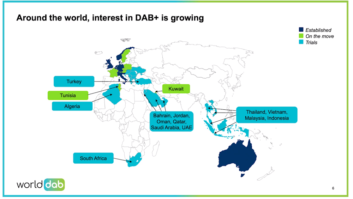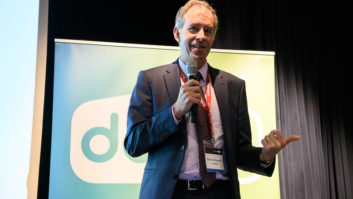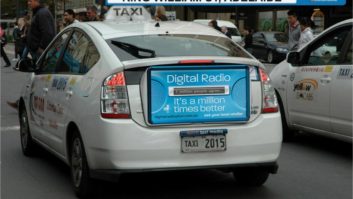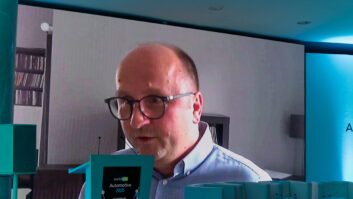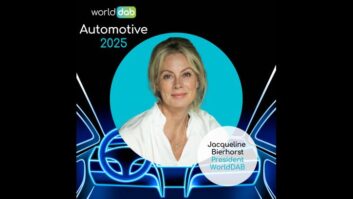LONDON — Digital Audio Broadcasting — DAB & DAB+ — has enjoyed mixed success since its introduction back in the early 1990s.
On a country-by-country basis, various strategies have been pursued in relation to establishing the technology. Some jurisdictions have been a great deal more proactive than others, and some have enjoyed considerable levels of uptake by the general public. Although it is sometimes difficult to correlate the degree to which deliberate policy approaches affect the public’s relative enthusiasm for the standard, the provision of additional services, for which analog carrying capacity would not be available, does appear to be one constant in most success stories about DAB.
DEGREES OF SUCCESS

More and more cars now have DAB fitted as standard.
Credit: WorldDAB
Ahead of the curve by some margin is Norway, which expects to have switched off all but the smallest of FM services across the country before the end of this year. Switzerland has also announced a formal timetable for so-called “digital switchover” (DSO), now confirmed to start in 2020, and complete the process by 2024.
Population coverage in Denmark, Germany, the Netherlands, Norway, Switzerland and the United Kingdom already is at 97 percent; and exceeds 75 percent in Italy. Permanent national or regional services are being rolled out in Belgium, the Czech Republic and Slovenia, with France recently announcing an acceleration to its rollout plans.
At the other end of the scale, however, there remain some European countries that have yet to embrace the standard to any material degree, though their number is reducing.
National trials are also underway in Hungary and Latvia, with more localized trials taking place in Austria, Greece, Bulgaria and Slovakia. In the Republic of Ireland, the public service broadcaster, RTE, operates a five-transmitter multiplex reaching just over 50 percent of the population and two regional trial commercial multiplexes are also operational.
Of course, the DAB standard is not used at all in some parts of the world, most notably the Americas and the United States in particular. However, according to WorldDAB, the body responsible for the promotion of the technology, well over 422 million people can now receive some of the 2,200+ DAB services operating in nearly 40 countries.
Some 55 million domestic DAB receivers had been sold by the end of last year, including around 14 million for in-car use. In Europe, 60 percent of new car sales are in countries with operational national DAB multiplexes.
RECEIVER SALES

The Plan de Corones transmission site in the Italian province of South Tyrol.
Credit: Hanns Wolter, DAB Italia
As a result, all major car manufacturers now offer DAB-capable in-car entertainment systems (ICE). Nearly all new cars sold in Norway (98 percent) and in the U.K. (87 percent) come with DAB and DAB+ capabilities as standard.
As market penetration increases, the cost of DAB receivers continues to fall, with designs available for as little as €14, below US$20. Major manufacturers provide DAB+ capabilities in all their designs and have done so for a number of years.
In Norway, all national services are now delivered using DAB+, and the popularity of this more recent version of the DAB standard is also increasing in countries such as the U.K., where it is used for some services on Sound Digital, the second national commercial multiplex, launched last year, as well as for services on some of the current small-scale localized trial multiplexes.
Although the majority of countries are not yet proactively pursuing concrete DSO dates, this does not mean that preparatory moves are not being made for such a change later.
Unlike Norway, many countries prefer “market lead” approaches to the process, setting digital listening targets as a prerequisite for mandating the digital switchover process.
For example, Denmark, which has enjoyed a range of DAB services for a number of years, plans to transition all of these to DAB+ this year and intends to decide its DSO strategy once digital reception accounts for 50 percent of all listening (that figure is now somewhere just below 40 percent).
DEFINING DIGITAL

The Valcava transmitting center in the province of Lecco in Northern Italy.
Credit: Hanns Wolter, DAB Italia
The definition of “digital listening” does tend to vary, though, from country to country, and it should not always be seen as synonymous with an equivalent uptake in the use of DAB.
For example, the U.K. defines “digital listening” as including listening to radio services via digital television platforms (satellite and terrestrial) as well as via web-based streaming services. However, government has also put into place a further protection for consumers, requiring that coverage of national DAB services (both BBC and commercial) must be equivalent to FM before any DSO process can begin.
Although the process of introducing DAB has made the greatest progress where it originated in Europe, the technology is also making inroads elsewhere.
In the Asia Pacific Region, the greatest success story for DAB+ is undoubtedly Australia, where DAB+ receivers are now available almost half of all households. DAB+ is available in five state capitals and new services are launching this year for Canberra, Darwin and Hobart.
Across the country, some 3.5 million people listen via a DAB+-capable device. Nearby New Zealand continues to operate the trial multiplexes that have been broadcasting there since 2006, and which are now delivering DAB+ services.
In China, four local multiplexes, carrying nearly 20 services between them, operate in the capital, Beijing.
WORLDWIDE GROWTH

DAB receivers come in all shapes and sizes, with prices now as low as €14. Pictured here is a Sangean digital radio receiver.
Credit: WorldDAB
In the Middle East, Kuwait launched permanent DAB+ services in 2014. Coverage of the current 15 DAB+ services on the national multiplex is already at 90 percent and is expected to reach 100 percent later this year, with two further stations also joining the single-frequency network (SFN).
Short-term trials have also taken place in nearby Bahrain, while in the United Arab Emirates plans are underway for the introduction of commercial DAB+ services in 2018.
State-run Turkish Radio and Television is operating trial DAB multiplexes in Istanbul, Bursa, Kocaeli and Ankara, each carrying five simulcast services and between them reaching some 20 percent of the population. Across the Mediterranean in Tunisia, North Africa, a trial multiplex is operational, carrying a dozen DAB+ services.
Perhaps because of the success of DAB in various major European markets in particular, more recently other countries around the world have begun to investigate its potential through trial transmissions.
In South Africa, broadcast regulator, the Independent Communications Authority of South Africa (ICASA), has extended the new South African DAB+ trial license for six months from Nov. 1 to April 2018, carrying some 20 services. Other trials are also progressing in Indonesia and Malaysia, while plans for the introduction of DAB+ are being explored in other countries, including Thailand and Myanmar.
It is perhaps an indication of how much progress has been made recently that it is now difficult to cover all DAB developments in a single article. However, this overview of the state of the standard clearly shows how much progress has been made since its launch toward the end of the previous century.
The road for DAB may have had more bumps than had been expected, and the broadcasting world is a very different place from what it was 20 plus years ago. However, the standard does now appear to be reaching some worthwhile destinations in terms of both regulatory interest and consumer uptake.
Lawrie Hallett, the technical director of Future Digital Norfolk Limited, reports on the industry for Radio World from Norwich, England. He previously worked on community and digital radio policy at Ofcom.
